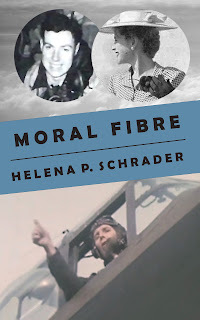Bridge to Tomorrow: A Novel of the Berlin Airlift in Three Parts
On 24 June 1948, the Soviet Union imposed a blockadeon the Western Sectors of Berlin. This cut off roughly 2.2 million civiliansfrom food, fuel, electricity, and all other necessities of life. The WesternPowers faced the choice between withdrawing from Berlin or using force to bringthe vitally needed goods across the Soviet Zone to the people of Berlin. The world stood poised on the brink of the Third WorldWar.
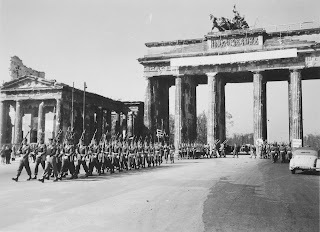 Withdrawal would have rewarded Stalin’s callous use of two million civilians ashostages and enabled the Soviet Union to absorb all of Berlin into thecommunist East. Yet the use of force risked provoking an armed response in theheart of Europe. Rather than risk war or concede defeat, theleadership in London and Washington decided to attempt to supply the cityentirely by air.
Withdrawal would have rewarded Stalin’s callous use of two million civilians ashostages and enabled the Soviet Union to absorb all of Berlin into thecommunist East. Yet the use of force risked provoking an armed response in theheart of Europe. Rather than risk war or concede defeat, theleadership in London and Washington decided to attempt to supply the cityentirely by air. This was seen as a stop-gap measure. It wasintended to buy time for diplomacy. No one in Washington, London, or Berlinseriously believed it would be possible to supply more than two millioninhabitants by air alone. Yet against the odds, the Airlift proved successful,and the Soviet Union gave up the Blockade after eleven months. The BerlinAirlift represented the first Western victory in the Cold War and remains tothis day a dramatic example of a successful, non-violent response toaggression.
Yet while people may have heard of the BerlinAirlift, few realize how close it came to failing or fully grasp itssignificance. The Berlin Airlift brought about a fundamental transformation inthe character and ideological orientation of post-war Germany. It transformedenemies into allies. It contributed materially to the establishment of theFederal Republic of Germany, NATO and ultimately the European Union.
As a long-time resident of Berlin, the BerlinAirlift always inspired me, yet I did not study the topic in earnest until TheHistory Press in the UK commissioned me to write a book for the 60thAnniversary. At the time, many German, American and British participants werestill alive. So, in addition to the usual scholarly research, I contactedeyewitnesses, starting with those still living in Berlin. I had the greatprivilege of corresponding with Gail Halvorsen, the famous “Candy Bomber”himself, and I also travelled to the UK to interview many British participants.These encounters planted the seeds for a novel -- or two.
Yet while the topic attracted me, it daunted me aswell. The situation in Berlin in 1948-1949 was extremely complicated. The castof characters was great and diverse. The relationship between the variousactors was fluid and nuanced. Focus on a single character or plot line promisedonly to distort and oversimplify the historical situation. I chose, therefore,to create an expansive, inclusive and intricate novel intended to do justice tothe complexity of the situation.
The richness of the material demanded breaking thestory into phases. The Airlift cannot be appreciated without firstcomprehending the situation in Berlin before theSoviet blockade. Berlin in 1948 was unlike any other place on earth. The scaleof destruction and the depth of the psychological trauma exceeded that of Tokyo,Frankfurt, or Rome. In addition, the simultaneous presence of all four wartimeallies in the city created unique political pressures and fissures. The resultwas a poisonous cocktail composed of crime, terror, mutual suspicion and widespreadhopelessness.
Instead of a single volume, a trilogy subsumed underthe overarching title Bridgeto Tomorrow evolved. The title springs from the German term for theAirlift, “Luftbruecke,” which translates literally as “Air Bridge,” and thefact the Airlift was a pivotal turning point between the post-war era and the ColdWar. Cold Peace is the first volume in the trilogy and coversthe period from late 1947 to the end of June 1948. It introduces most — but notall — of the major characters in the complete work Bridge to Tomorrow. In the weeks ahead I will be introducing the individual characters on this blog.
Cold Peace is Book I of the Bridge to Tomorrow Series.
Three years after WWII, Europe struggles with rationing, widespread unemployment and a growing Soviet threat. Hitler's former capital lies ruined under the joint control of wartime allies bitterly at odds. With the currency worthless, the population lives on hand-outs or turns to crime and prostitution. Deep inside the Soviet Zone of occupation, Berlin appears to be an ideal target for a communist take-over, putting the defenders of democracy on a collision course with Stalin's merciless aggression.
A Battle of Britain ace, a female air traffic controller, a concentration camp survivor and an ex-ATA woman pilot are just some of those trying to find their place in the post-war world. An air ambulance service offers a shimmer of hope, but when a Soviet fighter brings down a British passenger liner, Berlin becomes a flashpoint. The world stands poised on the brink of World War Three.
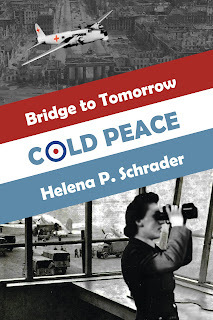
Find out more at: https://www.helenapschrader.com/bridg...
Previous releases include:
" MORAL FIBRE," which WON THE HEMINGWAY AWARD 2022 FOR 20TH CENTURY WARTIME FICTION and a MAINCREST MEDIA AWARD FOR MILITARY FICTION as well as being A FINALIST FOR THE BOOK EXCELLENCE AWARD 2023 IN THE CATEGORY HISTORICAL FICTION.
Riding the icy, moonlit sky,they took the war to Hitler.
Their chances of survival were less than fifty percent.
Their average age was 21.
This is the story of just one bomber pilot, his crew and the woman he loved.
It is intended as a tribute to them all.
or Barnes and Noble.
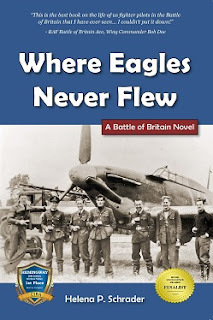 "This is the best book on the life of us fighter pilots in the Battle of Britain that I have ever seen.... I couldn't put it down."-- RAF Battle of Britain ace, Wing Commander Bob Doe.
"This is the best book on the life of us fighter pilots in the Battle of Britain that I have ever seen.... I couldn't put it down."-- RAF Battle of Britain ace, Wing Commander Bob Doe.
Winner of a Hemingway Award for 20th Century Wartime Fiction, a Maincrest Media Award for Military Fiction and Silver in the Global Book Awards.
Find out more at: https://crossseaspress.com/where-eagles-never-flew
For more information about all my books visit: https://www.helenapschrader.com
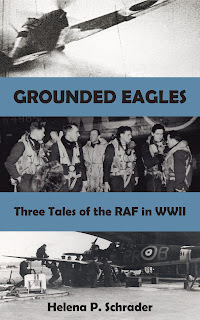 Disfiguring injuries, class prejudice and PTSD are the focus of three tales set in WWII by award-winning novelist Helena P. Schrader. Find out more at: https://crossseaspress.com/grounded-eagles
Disfiguring injuries, class prejudice and PTSD are the focus of three tales set in WWII by award-winning novelist Helena P. Schrader. Find out more at: https://crossseaspress.com/grounded-eagles

